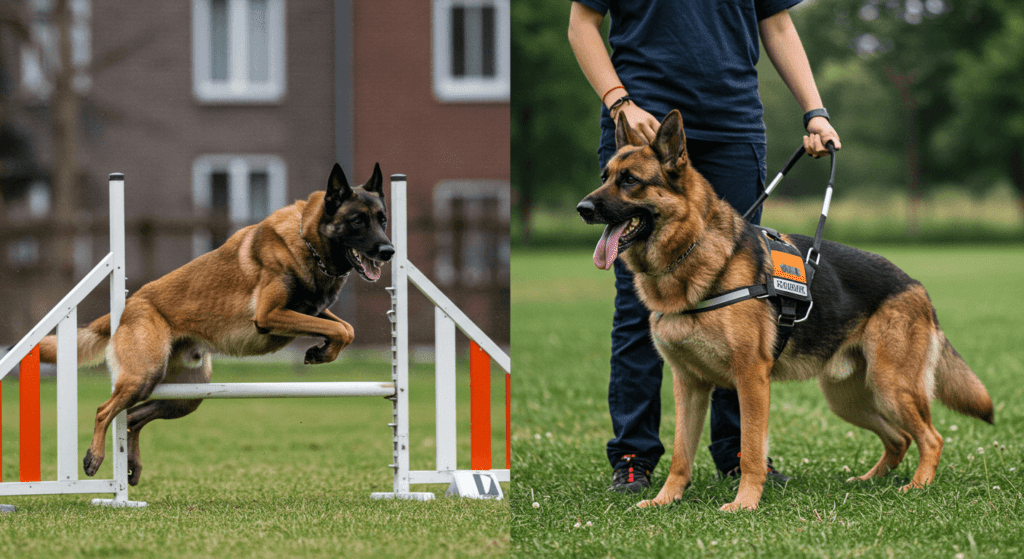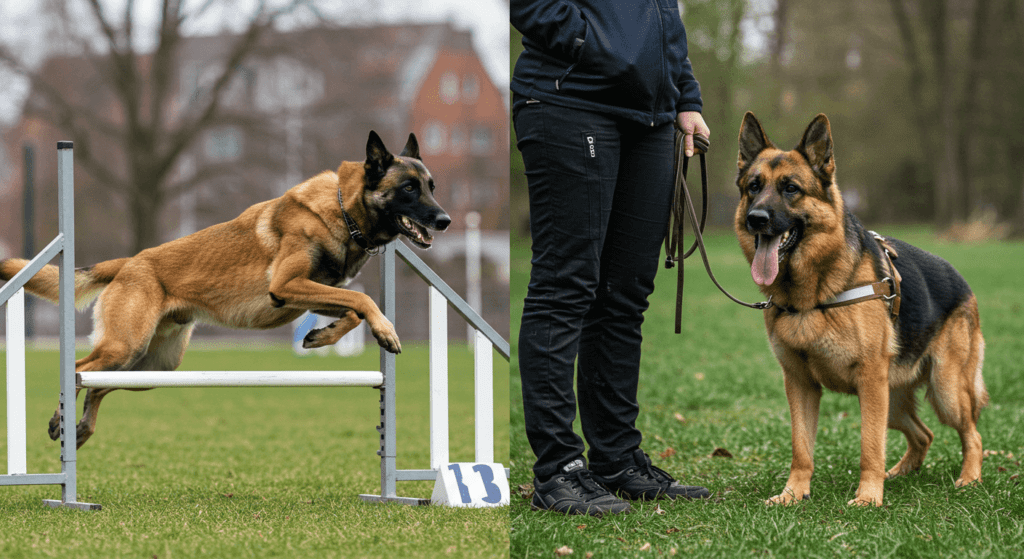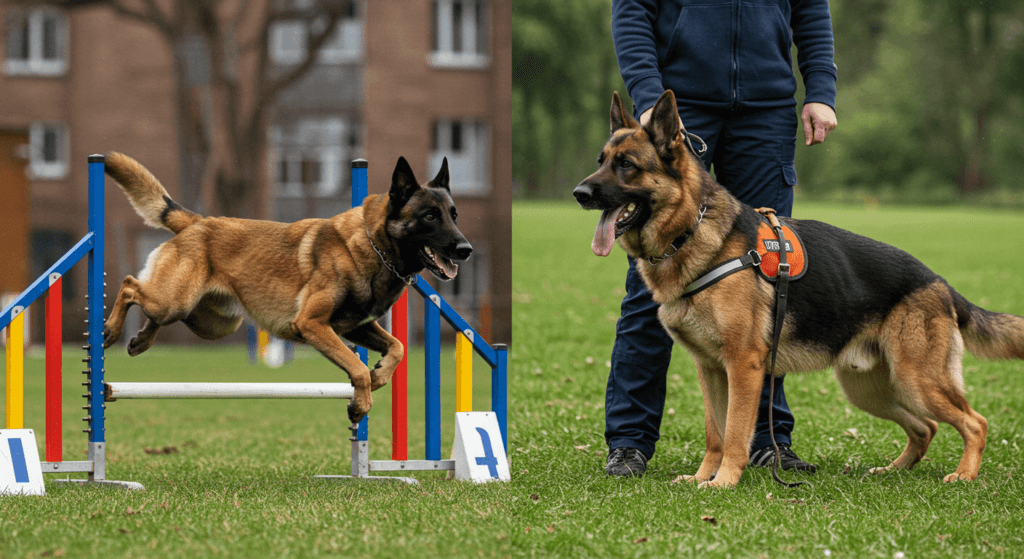Discover the key differences between Belgian Malinois vs German Shepherd breeds—from temperament to health—to choose the perfect loyal companion. 12,000-word guide.
Table of Contents
Choosing between a Belgian Malinois and a German Shepherd can be challenging. Both breeds are celebrated for their intelligence, versatility, and loyalty, but they cater to different lifestyles and needs. This 12,000-word guide dives deep into every aspect of the Belgian Malinois vs German Shepherd debate, from physical traits and temperament to health considerations and training requirements. Whether you’re a first-time dog owner or a seasoned handler, this article will equip you with the insights needed to make an informed decision.
Belgian Malinois vs German Shepherd: Physical Characteristics
Belgian Malinois
The Belgian Malinois is a medium-to-large breed, with males weighing up to 30 kg. Known for its athletic build and fawn sable coat, this breed boasts a striking black mask that extends from the lips to the eyelids. Its short, dense fur requires minimal grooming, making it ideal for active lifestyles. The Malinois’ almond-shaped eyes and upright ears exude alertness, while its muscular frame reflects its working-dog heritage.

German Shepherd
The German Shepherd is slightly larger, with males standing 60–65 cm at the withers. Its robust, elongated body is built for endurance, featuring a double coat that ranges from black-and-tan to sable. Unlike the Malinois, German Shepherds have a more pronounced muzzle and a bushy tail that curves upward when excited. Their dense undercoat makes them better suited for colder climates.
Key Differences:
- Coat: Malinois have shorter, low-maintenance fur; German Shepherds require regular brushing.
- Size: German Shepherds are generally heavier and taller.
- Color: Malinois are fawn sable, while German Shepherds exhibit more color variations.
For breed standards, refer to the American Kennel Club (AKC) guidelines.
Belgian Malinois vs German Shepherd: Temperament and Personality

Belgian Malinois
The Belgian Malinois is a high-energy, driven breed. Its intelligence and work ethic make it a favorite for military and police roles. While affectionate with families, it thrives in environments where it has a “job” to do. Without proper stimulation, Malinois may develop destructive behaviors. Early socialization is critical to manage their protective instincts.
German Shepherd
German Shepherds are equally intelligent but tend to be more adaptable to family life. They are loyal, calm, and naturally wary of strangers, making them excellent guard dogs. Though energetic, they are less intense than Malinois and can adapt to moderate exercise routines.
Key Differences:
- Energy Levels: Malinois require rigorous daily exercise; German Shepherds need moderate activity.
- Socialization: Malinois demand early, intensive socialization; German Shepherds are more naturally balanced.
- Work Drive: Malinois excel in high-stakes roles (e.g., K9 units); German Shepherds shine in versatile tasks (e.g., service dogs).
Learn more about temperament training from the International Association of Canine Professionals (IACP).
Belgian Malinois vs German Shepherd: Health and Lifespan

Belgian Malinois
This breed is generally hardy, with a lifespan of 12–14 years. While hip dysplasia is a concern in many large breeds, the Malinois is less prone due to its lean build. Regular vet check-ups and a high-protein diet are recommended to maintain their athletic physique.
German Shepherd
German Shepherds have a lifespan of 9–13 years and are more susceptible to hip and elbow dysplasia. Responsible breeding and health screenings, such as those endorsed by the Orthopedic Foundation for Animals (OFA), can mitigate risks. Bloat and degenerative myelopathy are additional concerns.
Key Differences:
- Lifespan: Malinois often live longer.
- Health Risks: German Shepherds face more genetic health issues.
Belgian Malinois vs German Shepherd: Training and Socialization
Belgian Malinois
Training a Belgian Malinois requires consistency and mental challenges. They excel in agility, obedience, and protection sports. Positive reinforcement and play-based methods yield the best results. Due to their strong prey drive, leash training is essential.
German Shepherd
German Shepherds are highly trainable and eager to please. They respond well to structured routines and excel in roles like search-and-rescue or therapy work. Their calm demeanor makes them easier to handle for novice trainers.
Pro Tip: Enroll in certified programs like Fenzi Dog Sports Academy for advanced training.

Belgian Malinois vs German Shepherd: Living Conditions
Belgian Malinois
This breed thrives in rural settings with ample space to run. Apartment living is feasible only with dedicated exercise (2+ hours daily). Malinois are not suited for sedentary households.
German Shepherd
German Shepherds adapt better to urban environments but still require daily walks and mental stimulation. They bond closely with families and struggle with prolonged isolation.
Conclusion
Conclusion: Belgian Malinois vs German Shepherd – Which Breed Is Right for You?
The Belgian Malinois vs German Shepherd debate ultimately boils down to your lifestyle, experience, and expectations. Both breeds are exceptional in their own ways, but they cater to vastly different needs. Here’s a final breakdown to guide your decision:
Key Takeaways
- Energy & Activity Needs:
- The Belgian Malinois is a high-octane, working-class breed that thrives in roles requiring agility, speed, and mental challenges. Ideal for active handlers, law enforcement, or competitive sports.
- The German Shepherd is versatile and adaptable, balancing energy with calmness. Suitable for families, service roles, or moderate-activity households.
- Temperament & Socialization:
- Malinois demand rigorous early socialization and consistent training to manage their intense drive and protective instincts. Best for experienced dog owners.
- German Shepherds are naturally loyal and easier to socialize, making them a better fit for first-time owners or families with children.
- Health & Longevity:
- Malinois generally live longer (12–14 years) and face fewer genetic health risks, though hip dysplasia remains a consideration.
- German Shepherds have a shorter lifespan (9–13 years) and are more prone to hip/elbow dysplasia and degenerative conditions. Responsible breeding is crucial.
- Living Environment:
- Malinois need space to run and a “job” to stay mentally stimulated. Rural settings or active households are ideal.
- German Shepherds adapt well to apartments or suburban homes, provided they receive daily exercise and companionship.
- Training & Roles:
- Malinois excel in high-stakes roles (military, K9 units) and thrive on advanced training.
- German Shepherds shine in versatile tasks (therapy, search-and-rescue) and are more forgiving for novice trainers.
Final Recommendation
- Choose a Belgian Malinois if:
You’re an experienced handler, have ample time for training/exercise, and seek a dog for protection, sport, or demanding work. - Choose a German Shepherd if:
You want a loyal family guardian, a versatile working companion, or a dog that balances energy with adaptability.